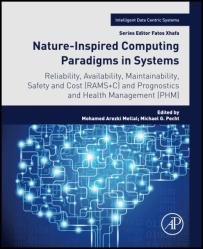Nature-Inspired Computing Paradigms in Systems
- Добавил: literator
- Дата: 27-09-2021, 12:49
- Комментариев: 0
 Название: Nature-Inspired Computing Paradigms in Systems
Название: Nature-Inspired Computing Paradigms in SystemsАвтор: Mohamed Arezki Mellal, Michael G. Pecht
Издательство: Academic Press/Elsevier
Год: 2021
Страниц: 132
Язык: английский
Формат: pdf (true)
Размер: 10.2 MB
Nature-Inspired Computing Paradigms in Systems: Reliability, Availability, Maintainability, Safety and Cost (RAMS+C) and Prognostics and Health Management (PHM) covers several areas that include bioinspired techniques (algorithms) and optimization approaches for system dependability.
The book addresses the issue of integration and interaction of the bioinspired techniques in system dependability computing so that intelligent decisions, design, and architectures can be supported. It brings together these emerging areas under the umbrella of bio- and nature-inspired computational intelligence.
The book is divided into eight chapters. Chapter 1 deals with the reliability optimization of a safety system in the power plant using gray wolf optimizer (GWO) and the shuffled flog-leaping algorithm (SFLA). Chapter 2 addresses the design optimization of the car side safety system using particle swarm optimization (PSO) and gray wolf optimizer (GWO). Chapter 3 presents the basic principles of genetic algorithm and its application in RAMS. Chapter 4 uses evolutionary optimization for resilience-based planning in power distribution networks. Chapter 5 presents a review of the application of nature-inspired computing in optimal design. Chapter 6 uses artificial neural networks and genetic algorithms for fire safety strategies assessment. Chapter 7 applies artificial neural networks to proton exchange. Finally, Chapter 8 addresses reliability redundancy allocation problems with uncertainties using genetic algorithms and dual-connection numbers.
Swarm intelligence algorithms. A significant number of insects and other minor animals, such as flies, bees, fish, etc., are typically arranged in hierarchies in nature. These social insects demonstrate a remarkable ability to solve complicated problems, such as forming their nest or determining the shortest path between their nest and the food supply. The term “swarm” is used for a large number of insects or other small creatures that carry out group behavior, such as bees, social wasps, termites, ants, or an aggregation of animals or birds such as fish, cats, dogs, etc. Swarm Intelligence (SI) is an Artificial Intelligence (AI) branch that studies the collective actions and emerging properties of complex, self-organized, socially structured, decentralized systems. SI aims to simulate the behavior of any loosely structured collection of interacting agents. Emergent behavior is only attainable through local communications among system constituents and cannot be achieved by any individual component of the system by acting unaided. The SI system is capable of operating in a synchronized fashion without any coordinator or external controller.
This book can be used by researchers, students, engineers, industrial companies, or any person interested in nature-inspired computation and RAMS+C & PHM. The book is also intended to be used as a textbook for masters and doctoral students who want to enhance their knowledge and understanding of the role of bioinspired techniques in system dependability.
Скачать Nature-Inspired Computing Paradigms in Systems
Внимание
Уважаемый посетитель, Вы зашли на сайт как незарегистрированный пользователь.
Мы рекомендуем Вам зарегистрироваться либо войти на сайт под своим именем.
Уважаемый посетитель, Вы зашли на сайт как незарегистрированный пользователь.
Мы рекомендуем Вам зарегистрироваться либо войти на сайт под своим именем.
Информация
Посетители, находящиеся в группе Гости, не могут оставлять комментарии к данной публикации.
Посетители, находящиеся в группе Гости, не могут оставлять комментарии к данной публикации.
